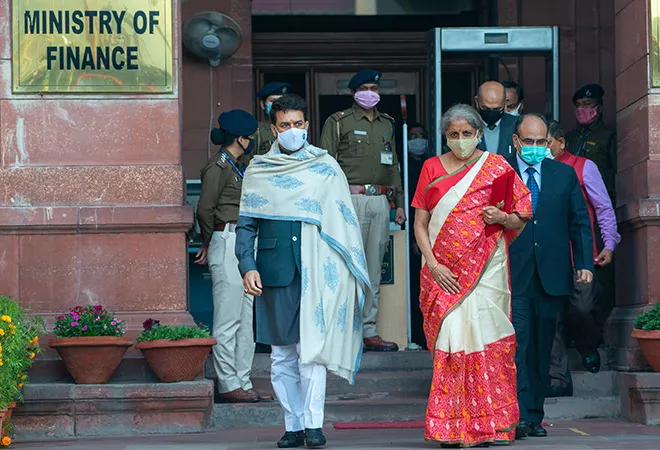-
CENTRES
Progammes & Centres
Location

Image Source: Getty
The ongoing pandemic and resultant contraction in the economy has put the budget making this year in bit of a predicament. On the one hand, there is a necessity to spend enough to take the economy out of the doldrums. On the other, shrinking revenue collections makes that job tough. Abiding by the general rule to keep the fiscal deficit down makes these two opposite tasks more difficult than ever.
The Budget documents provide a snapshot of the receipt and expenditure budget. These two diagrams provide a snapshot of “where a rupee comes from” and “where that one rupee goes”.
These two diagrams demonstrate the dilemma the Finance Minister probably faced this year. Borrowings and other liabilities have increased from 20 paise in 2020-21 BE (budget estimate) to 30 paise in 2021-22 BE—in a rupee. Other sources of revenues, including income and corporation tax, GST (goods & services tax), and non-tax revenue, have fallen down. This implies that the government has to borrow more to spend (Figure 1).
FIGURE 1: A rupee comes from (in paisa): Receipt Budget at a glance
 Source: Budget at a Glance, Union Budget 2021-22
Source: Budget at a Glance, Union Budget 2021-22
On the expenditure side, allocations for centrally-sponsored schemes and central sector schemes have been kept intact. So have the Finance Commission and other transfers—in terms of a rupee. Proportional expenditure on defence also remains the same in 2021-22 BE. Quite expectedly, expenditure on subsidies has increased from 6 paise in 2020-21 BE to 9 paise in 2021-22 BE in 2021-22 BE—in a rupee estimated to be spent. Expenditure of interest payments, however, has increased. (Figure 2).
The resultant cut has mainly come from the States’ share of taxes and duties. When the central revenue falls due to a fall in overall GDP of the economy, then this is quite natural. But then this cut makes the state government’s job more difficult than usual. States have to spend on state subjects like health and agriculture. This spending is expected to provide relief to the pandemic-hit economy, but a falling allocation from the Centre may limit the scope of intervention of the state governments in the next one year.
Of course, the blame for this cannot be attributed to the central government as the pandemic came as an external shock that has ravaged the economy. However, there is the option to borrow more, without pondering too much about the mounting fiscal deficit for the time being. The Union Government has taken the traditional path of abiding by the assumption that a lower fiscal deficit is a target which cannot be ignored even during a pandemic. Whether this stance will pay dividends or not, only time will tell.
FIGURE 2: A rupee goes to (in paisa): Expenditure Budget at a glance
 Source: Budget at a Glance, Union Budget 2021-22
Source: Budget at a Glance, Union Budget 2021-22
If the economy is in a contraction, then along with output other fundamentals like employment and purchasing power also fall. This leads to a lack of demand. Here, it is crucial to remember that the economy was experiencing a shortage of demand even before the pandemic.
In a demand-constrained economy, real sector (the brick and mortar economy) activities do not pick up unless there is a direct fiscal intervention. If activities do not pick up, then further suppression of output may follow and that implies dwindling revenue—among other repercussions.
In a way then, avoiding more spending to remain at lower levels of fiscal deficit feeds into the negative multiplier in the economy. Not spending enough also assumes a certain amount of optimism about immediate revival of the economy. Fiscal deficit is at 9.5% of the GDP in 2020-21 RE (revised estimates). This budget endeavours to bring it down to 6.8% in the next fiscal (Table 1). If the economy revives then it may be possible, but assuming an automatic recovery to 2019 level has its own inherent risks. This budget, for the time being, ignores that risk.
| TABLE 1: Deficit Statistics (in Rs. crore and % of GDP) | ||||
|
2019-20 Actuals |
2020-21 Budget Estimates |
2020-21 Revised Estimates |
2021-22 Budget Estimates |
|
| Fiscal Deficit |
933651 (4.6) |
796337 (3.5) |
1848655 (9.5) |
1506812 (6.8) |
| Revenue Deficit |
666545 (3.3) |
609219 (2.7) |
1455989 (7.5) |
1140576 (5.1) |
| Effective Revenue Deficit |
480904 (2.4) |
402719 (1.8) |
1225613 (6.3) |
921464 (4.1) |
| Primary Deficit |
321581 (1.6) |
88134 (0.4) |
1155755 (5.9) |
697111 (3.1) |
|
* Figures in brackets are deficit figures as percentage to GDP. Source: Budget at a Glance, Union Budget 2021-22 |
So, the correct intent shown in the Budget Speech is often not reflected in actual allocation in the current year. An allocation of INR 64,180 crore for the next six years for Atmanirbhar Swasth Bharat Yojana, INR 20,000 crore earmarked for recapitalisation of banks, and INR 1,41,678 crore for the Urban Swachh Bharat Mission for the next five years are some of the examples. More often than not, quite a few of these expenditures overlap with some other existing budgeted expenses. The details of the allocations, of course, need to be minutely re-checked, but the opposing intents of undertaking expenditures to kickstart the economy while simultaneously keeping the fiscal deficit down will most likely result in inadequate allocations.
Like last year’s budget, the 2021-22 budget also does not make any exceptions on that count.
The views expressed above belong to the author(s). ORF research and analyses now available on Telegram! Click here to access our curated content — blogs, longforms and interviews.

Abhijit was Senior Fellow with ORFs Economy and Growth Programme. His main areas of research include macroeconomics and public policy with core research areas in ...
Read More +